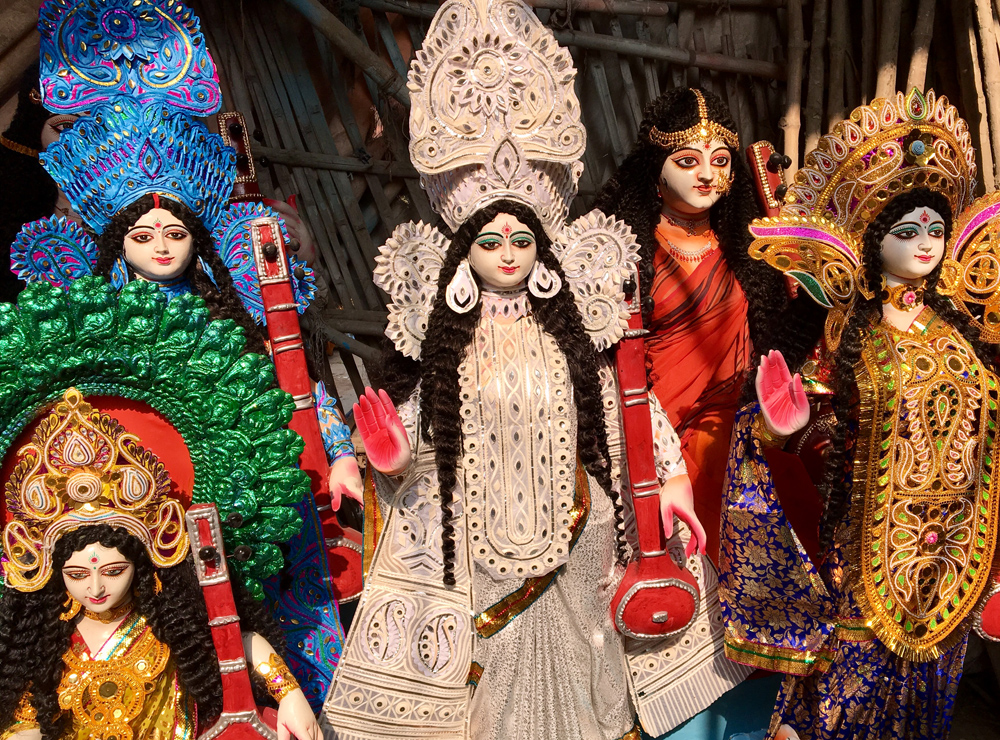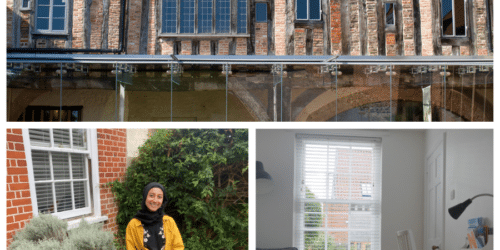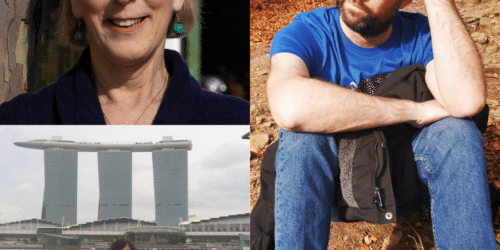
In late January, WCN invited three UK writers – Sarah Bower, Lucy Hughes-Hallett and Tiffany Atkinson – on a trip to Kolkata as part of Writing Places, our ambitious creative writing and literary translation-led project that aims to explore connections between writing and place in Kolkata and Norwich.
They took part in the Kolkata Literary Meet and Literary Activism Symposium, in addition to a literary translation winter school organised by WCN in partnership with BCLT and CENTIL at Jadavpur University. Below, Sarah Bower paints a rich picture of her experiences during the visit – from Eden Gardens, the homeof Indian cricket, to the spring festival Saraswati Puja.
India. Not so much a country as a spell to conjure extreme and contrasting images. Ancient yogic enchantments and Bollywood musicals, crumbling temples and the flashy tech-hubs of Bengaluru, cattle in the streets and rockets in space, ayurvadic healing and a nuclear arsenal. India, of a thousand gods and one religion: cricket. Sachin Tendulkar, whose one hundred international centuries locate him at the pinnacle of the pantheon. M. S. Dhoni, to whom a temple was dedicated in his home town of Ranchi, in Bihar. Ganguly, Gavaskar, the Nawab of Petaudi.
The spiritual home of Indian cricket is Eden Gardens, perhaps, along with the MCG in Melbourne, the ground on which cricket’s gladiatorial aspect has been most finely and ferociously honed. The Board of Control for Cricket India describes the ground as having a 66,000 capacity. I have spent the small hours of many a morning listening to test matches broadcast from Eden Gardens at which twice that number bayed for the blood of English batsmen half way across the globe. The cacophony of horns and fireworks and the ritual chants of the names of the Indian gods have been there in my dreams for as long as I can remember.
When I was invited to go to Kolkata, as part of the Writing Places project, supported by the Arts Council England and British Council ReImagine India fund, Eden Gardens was immediately the place about which I most wanted to write, a ground as iconic as Lords, but as like Lords as a fresh-fried dhal puri is to a cold bacon sandwich. If the crowd at Lords is the Church of England at play, the crowd at Eden Gardens is Kali dancing on Shiva’s chest.
Ancient yogic enchantments and Bollywood musicals
My first question to our British Council hosts, Arnab Banerjee and Shonali Ganguli, is, how do I buy a ticket to see a game at Eden Gardens? Arnab’s face displays a curious mixture of dismay and exultation. Didn’t I realise I had missed England playing India in a one day international by a week? Was I aware India had graciously allowed England a narrow win, having already won the series? Yes, and yes, thank you, no need to rub it in, but surely there would be some domestic cricket to be seen. Arnab isn’t sure, as the Indian Premier League, India’s festival of T20 pyrotechnics, with players changing hands for millions and teams which are the personal fiefdoms of billionaire businessmen and Bollywood stars, won’t begin until April.
But a tour of the ground might be possible. There is a man, said Arnab, at Gate 14. For Rs100 (about £1.50), he will show you into the ground whether or not there is a match on. You can take the BBD Bagh bus to Dalhousie Square. Or catch the ferry at Babughat, alighting at Howrah Station. At the mention of the ferry, my fellow traveller, the poet Tiffany Atkinson, reveals a delight in getting lost on public transport in strange places, and we begin to hatch a plan.
We (Tiffany and I and the biographer, Lucy Hughes-Hallett) are to spend Saturday and Sunday at the Kolkata Literary Meet, and Monday at Jadavpur University for the opening session of a two-day translation winter school, organised by the Centre for the Translation of Indian Languages (CENTIL), in order to meet the student groups who will work on producing consensus translations of our work.
A date is set for Tuesday for our Eden Gardens adventure. On Sunday evening, Tata, sponsors of the Literary Meet, hold a reception on their rooftop terrace. All eyes, as we drink our cold Tigers and survey the city below us in the dusk, are drawn to the Victoria Memorial Hall, its floodlit dome like some vast, cosmic meringue floating in a bluish custard. Shift your eyes a little to the right, however, and the fortress walls of the cricket ground loom, little more than a thickening of the evening, a mirage.
Tuesday morning dawns with the news that Wednesday is Saraswati Puja. Saraswati is the Hindu goddess of learning and wisdom, much loved by Kolkatans, who have a fierce intellectual tradition. Celebrations focus on the education of children. It is considered lucky for a child to do her or his first writing on Saraswati Puja, and parents will push pens into the fists of tiny babies and guide their hands as they write. Clay idols of the goddess – enigmatically smiling, with one of four pink-palmed hands raised in blessing and another holding her veena (a long-necked lute) – are taken into the home, school or workplace for the duration of the puja, then cast into the Hooghly River (which is the Ganges by another name – we are in Bengal, remember, not exactly India) on the days following. These clay idols are manufactured in Kumartuli, the potters’ district, and we’re advised today would be a good day to go there, when the idol manufacture is in full swing for the puja on Wednesday. The mirage recedes.
its floodlit dome like some vast, cosmic meringue
Kumartuli is a compact district of narrow lanes where the idol makers pursue their craft in open-fronted workshops. The idols begin as straw frames, around which the images of the gods and goddesses are moulded from the grey clay extracted from the Hooghly. They are then painted and dressed. Although Saraswati is traditionally depicted in white, for her purity and unworldliness, many of her manifestations for the coming puja are gorgeous in gold and flame colours, her veena painted scarlet and her headdress encrusted with coloured glass. She sits on a lotus flower, and her familiar, the swan, cranes its neck from among her skirts. Each stage of her enfleshment is presided over by specialists, from those who mould the clay to those who devote themselves to painting on her eyelashes or the fuchsia lines on her palms. They work with absorption, paying only scant mind to we four white women with our cameras.
Families, groups of work colleagues and parties of excited schoolgirls arrive at the workshops to purchase their idols. It’s a little like going to buy a Christmas tree. People squabble over their selection in open shop fronts where the idols line up smiling on beaten earth floors, each ever so slightly not identical to her sisters. Perhaps one is a little more sloe-eyed and the other’s swan cranes its neck at a different angle. Once an idol is chosen, she begins her journey to her new home on the back of a van, in a bicycle rickshaw, hoisted at shoulder height through the dusty alleyways by groups of jolly young men.
Kumartuli, a day before the puja, is full of colour and argument, but in the dusky backs of workshops or narrow yards where only the pi-dogs go, another goddess waits. She is naked, her clay flesh dried to ghost grey. She doesn’t even have her head yet, but we know who she is, with her wrestler’s stance, her big belly and staring breasts. This is Kali, Kolkata’s presiding deity, and beneath her feet writhes Shiva, her husband, while she dances on his chest.
On the way to Kumartuli, we passed close enough to Eden Gardens to touch it, its four massive floodlight towers rising out of the maidan like H. G. Wells’ Martians, its flanks planted solidly behind a protective moat of dual carriageways. Tiffany is still my willing partner in my quest, wooed by the thought of the ferry, and now, as we travel with him to Jadavpur, Arunava Sinha adds further delight to the prospect by telling us there’s a secret garden hidden in a corner behind the ground, a tropical garden visited by hardly anyone and next to it a graveyard of rusting jeeps, reclaimed by the jungle. Elusive Eden, encrusted with myth.
The following evening, we take a river cruise at dusk, the setting sun no more than a lurid smudge on the smog-blurred western horizon. We sail past temples and factories, the city crematorium whose chimneys are jauntily painted in the state colours of pale blue and white (I am deeply disappointed to discover the dead are no longer burnt on the funeral ghats, open to the air and the ubiquitous crows), knots of boys flying kites with serious, competitive urgency. A disembodied call to prayer floats across the water, dueting with Bangla pumped from a deserted, fairy-lit dance floor. Every gap between buildings, every cracked wall or smashed window, seethes with jungle greenery, and I am Marlowe and Eden Gardens is my Kurtz.
Once the translation winter school ends, with readings of the translated work, during which I helplessly scan the faces of the audience for some clue as to what my own story means in Bengali, we have some time to explore the city in our own ways. Still hoping to hear from one or other of the people who have been suggested to me as guides to the cricket ground, I decide to begin with the great temple of Kali at Kalighat.
A disembodied call to prayer floats across the water
The Kolkata metro is a dislocating experience. Its stations are roomy, quiet and spotlessly clean. Kolkata is the reverse of the trope of a fictional dystopia, where underground is order and permanence and modernity and above ground is chaos and a pervasive sense of imminent disintegration. Tangles of electricity cables nested in trees, drivers playing chicken with one another as they swerve around dogs and children, tuktuks and rickshaws.
The metro does not prepare me for the bustle and blaze of the temple yard and its arterial alleyways. Saturday, worshippers explain apologetically, is Kali’s day. On Saturday, you will queue to see her, possibly for hours. But first you will leave your shoes at least a hundred yards from the outer precincts of her temple and your tender white feet will tread recklessly among the goddess alone knows what in the little streets surrounding her house. You will pass tethered goats awaiting sacrifice and the remains of goats which have been sacrificed. Kali likes blood; where Saraswati carries her veena, Kali wields a machete with which she cuts off men’s heads. You will be marked with ash and vermillion paint for reasons which aren’t entirely clear and you will vex your guide, when he asks you to pray for family members, by telling him your parents are dead and you no longer have a husband. You bring the name of another man secretly to the altar and wonder about the security of his head. Scarlet hibiscus wilt in your slightly panicky palm.
Afterwards, I buy rosewater sweets in a tiny basket stapled from a banana leaf and a brass image of the goddess who now sits in the north east corner of my apartment, as instructed. She has a baleful gaze. She brings luck. Of a kind. I think.
We spend two days at Presidency University, at a symposium on reassessments of literary and intellectual history arranged jointly by Jon Cook and Amit Chaudhuri, as part of the UEA in India project. We enjoy ‘the worst coffee shop in the world’ and the second hand bookstalls that don’t merely line College Street but make it impassable. (I find a slender volume of essays by William Morris, published in Kolkata.) All too suddenly, it’s our final day in the city, which we begin with an early morning walk through its cultural history, from seventeenth century Armenian merchants, through Hakka Chinese leather tanners and lofty Zoroastrian philanthropists, to the representatives of the Honourable East India who perished in the Black Hole.
As the walk ends, we drink water from green coconuts, freshly macheted, and I make a final desperate onslaught on the gates of Eden. Does our guide happen to know the schedule? Might there be a game that afternoon? It’s a Sunday, so I’m hopeful. Our guide turns out to be possibly the only Indian I shall ever meet who knows nothing about the game. His driver, however, is a different kettle of bekhti.
En route back to our hotel he suddenly swerves into a coned-off lane of the dual carriageway bordering Eden Gardens, abandons us and darts off through an unattended gate into an apparently empty ground. Mystifying minutes later, he returns and beckons me out of the car and abruptly, without fanfare, or Tiffany, or any adventures with ferries or the ghosts of jeeps, I am crossing the familiar no man’s land which lies between the gates and the stands of any big cricket ground. It is empty except for a single chai wallah attending to a battered kettle set on a gas burner.
‘Cricket?’ I enquire doubtfully of the driver.
‘Yes, yes,’ he confirms, pointing me towards the stands.
‘How much?’ I ask.
‘Free,’ he assures me, and up the steps I go as he returns to his car and my doubtless bewildered travelling companions.
There is indeed cricket, a couple of twenty over games being played between different districts of Bengal. Only one stand is open in the vast ground which, in its pomp, could hold 120,000, and that scarcely occupied. There are family groups, and several knots of boys in grubby whites, fresh from their own Sunday games on the maidan, and one exuberant party of young Assamese men whose team is definitely the best of the four I see. I attract a few glances; there is only a handful of women in the ground and no other Europeans. But I’m nowhere near as interesting as the game and am soon ignored. The cricket is of a good standard, my seat is close to the wicket, the weather is perfect English June as afternoon draws into evening and the crows begin their roosting conversations and a pale half moon rises above the stands. This is not the Eden Gardens I know from listening to Test Match Special in the small hours, its roar thundering through my radio speaker, but Eden it is, with just the ragged cheers of the Assamese, the barked instructions of captains setting their fields, and the chai wallah calling ‘Chai-ee’ as he swings his kettle between the empty seats.
About Sarah Bower
Sarah Bower is the author of three novels and her work has been translated into ten languages. Her first novel, The Needle in the Blood, won the Susan Hill Award 2007 and her second, The Book of Love, was a Toronto Globe and Mail bestseller. Her most recent publication is Erosion, written under the penname S. A. Hemmings. She has taught creative writing at UEA, Lingnan University in Hong Kong and the Open University as well as for the Unthank School. She holds an MA in creative writing from the University of East Anglia, and was shortlisted for the Curtis Brown scholarship in 2001. She works as a mentor to fellow novelists and co-founded the mentorship scheme for literary translators with the British Centre for Literary Translation, now managed by Writers’ Centre Norwich.







